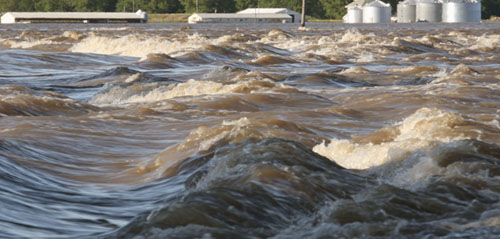 A year after floodwaters eroded sections of the Missouri River basin, exposing and triggering the rupture of two petroleum pipelines, federal records suggest the same thing could happen to dozens of other pipelines. The records highlight a gap in regulations that could imperil pipelines buried beneath rivers nationwide.
A year after floodwaters eroded sections of the Missouri River basin, exposing and triggering the rupture of two petroleum pipelines, federal records suggest the same thing could happen to dozens of other pipelines. The records highlight a gap in regulations that could imperil pipelines buried beneath rivers nationwide.
Federal investigators plan to announce soon that flood-caused erosion along the riverbed -- known as scouring -- exposed an Exxon Mobil Corp. pipeline on the Yellowstone River in Montana in 2011, causing it to break and spill 1,000 barrels of crude, said a senior federal pipeline official speaking on condition of anonymity.
A month later, an Enterprise Products Partners LLP pipeline burst after it was exposed by scouring in a Missouri River floodplain in Iowa, spilling 818 barrels of a gasoline additive.
The greater weight and speed of floodwater can scrape dozens of feet of soil and gravel off a river's bed, potentially exposing pipelines and leading to their rupture. Heavy snow and rain last year caused record flooding on the Missouri River basin, which includes the Yellowstone.
In January, Congress ordered a review of pipeline incidents at river crossings to determine if the pipelines' depths were a factor. The study is expected to help lawmakers determine whether regulations should be strengthened.
Meanwhile, even as rivers across the nation's midsection shrunk this year amid a severe drought, new federal records show more pipelines could be at risk during any flooding.
The U.S. Geological Survey found severe scour last year at 27 sites surveyed along the Missouri River from Kansas City to St. Louis, with the riverbed deepened in places by nine to 41 feet. Other unpublished USGS research found more severe scouring upstream.
Of the 55 oil and gas pipelines that cross the Missouri -- which runs 2,300 miles from Montana to St. Louis -- at least 24 have sections that lie 10 feet or less beneath the riverbed, within the range of scour observed on the river, according to federal records obtained via a Freedom of Information Act request. During recent inspections, operators discovered at least two of those pipes, in Platte County, Mo. and near Boonville, Mo., were exposed but didn't break.
Federal law requires operators to bury pipelines a minimum of four feet beneath waterways. Many river engineers say that standard is grossly inadequate. A congressional research report this year said the 4-foot minimum "appears to be insufficient to prevent riverbed pipeline exposure."
The federal agency for pipeline safety, the Pipeline and Hazardous Materials Safety Administration, learned of the pipelines' depths through an optional survey of operators. When operators didn't report the depths of 12 pipelines in the survey, PHMSA said it didn't pursue the matter because it isn't required to track pipeline depths.
Under current rules, PHMSA leaves much of the oversight of pipelines to operators, who are required to inspect river crossings every five years.
Exxon declined to comment on the cause of the Montana spill pill because the investigation isn't complete. The company said it is "committed to safe pipeline operations, and we have applied what we have learned into our operations."
Following the Exxon-pipeline rupture, PHMSA and Montana officials pushed pipeline operators to inspect their river crossings in the state. The review found that about a quarter of the roughly 90 pipelines inspected were dangerously close to exposure, said Richard Opper, director of the Montana Department of Environmental Quality and chair of the state's pipeline safety council.
Those findings "tell me that we're vulnerable. But not just in Montana. The whole pipeline system across the country's vulnerable," Mr. Opper said. The pipeline companies are working to rebury the Montana pipelines, he said.
John Stoody, spokesman for the Association of Oil Pipe Lines, called scouring "a real but rare risk." Operators spent $1.1 billion last year on managing the integrity of their pipelines, he said. Reinstalling shallow pipelines at river crossings across the nation would cost billions of dollars, he said, "and that would be a very high cost to consumers."
In 1994, scouring on a flooded river near Houston exposed 37 pipelines, including eight that broke, spilling 35,000 barrels of petroleum. A decade later, at the urging of federal officials, the American Petroleum Institute developed standards for designing pipelines across waterways and floodplains.
With those standards and new installation methods -- horizontally drilling a hole 15 to 60 feet beneath waterways and feeding a pipe through -- younger pipelines are less susceptible to scouring. But according to federal documents, nearly two-thirds of the pipelines that cross the Missouri were installed between 1930 and 1982 by digging a ditch, laying the pipe and burying it -- a method far more vulnerable to scour.












